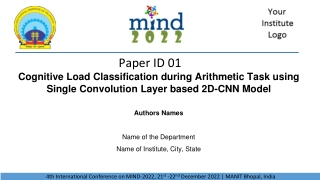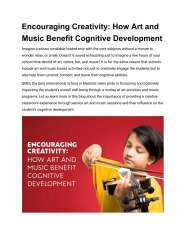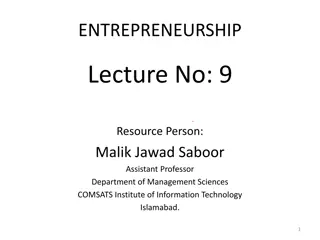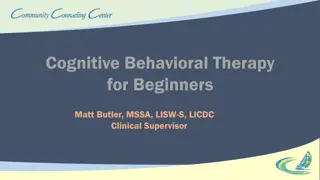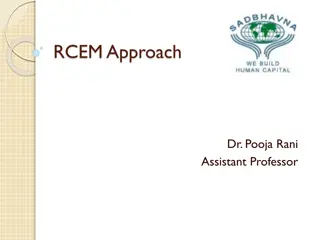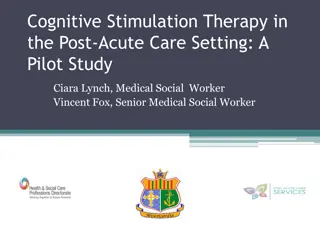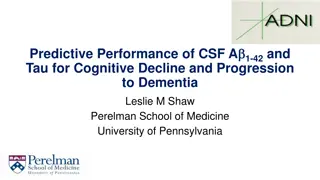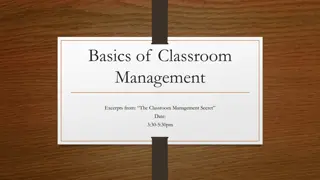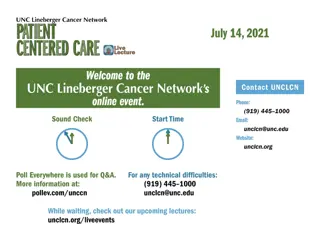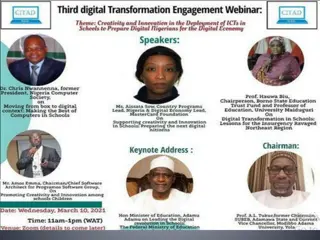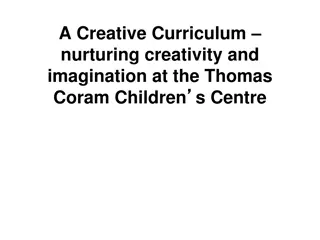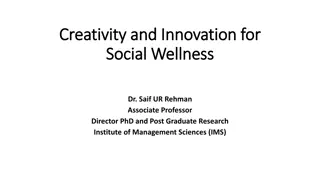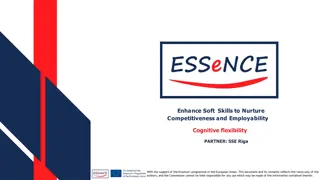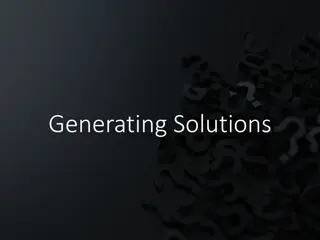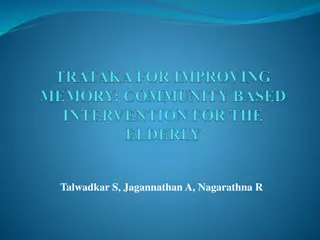Cognitive Aspects of Creativity in Classroom
Immerse in the seminar's insightful exploration of creativity within the classroom setting. Delve into cognitive aspects that foster innovation and inspiration, shaping a dynamic learning environment. Gain valuable perspectives on nurturing creative thinking and skills among students, enhancing their educational journey significantly.
Download Presentation

Please find below an Image/Link to download the presentation.
The content on the website is provided AS IS for your information and personal use only. It may not be sold, licensed, or shared on other websites without obtaining consent from the author.If you encounter any issues during the download, it is possible that the publisher has removed the file from their server.
You are allowed to download the files provided on this website for personal or commercial use, subject to the condition that they are used lawfully. All files are the property of their respective owners.
The content on the website is provided AS IS for your information and personal use only. It may not be sold, licensed, or shared on other websites without obtaining consent from the author.
E N D
Presentation Transcript
1 Part A Cognitive Aspects of the Classroom Seminar 3 The Concept of Creativity
2 1. The Meaning of Creativity: 1.1 Some views of Creativity: Poincare(1924) the creative process. Inspirational view of creativity: For fifteen days I strove and reached no results. One evening, contrary to my custom, I drank black coffee and could not sleep. Ideas rose in clouds I had only to write out the results, which took but a few hours.
3 A popular view of creativity: Def: A quality possessed by the few men who have made and outstanding contibution in the arts or sciences. Ex: Beethoven, Shakespear, Einstein, Freud Ausubel(1963) defines creativity as: A rare and unique talent in a particular field of endeavour. These people are ceative only at certain times of their lives.
4 White s(1968) def Creative is not the name of an activity, or process at all, but rather a medal we pin on public products. Parson (1971) Disagreed: The term creative can be applied to works, persons, and processes, although it is primarily connected with persons. Applied to both products and their procedures.
5 Bruner (1962): A less elitist view. Defines creativity (creative process) as: One which results in an act that produces effective surprise novelty. Guilford: Creativity represents divergent rather than convergent thinking. Creativity is an ability possessed by all people, but in varying degrees.
6 Example used by Guilford: asking his subjects how many uses they could think of for a Brick. Responses responses in diff Covergent thinking Merely listed things that could be built with it. categories(make a door stop, throw at a dog,make a red powder, drive a nail, ) Divergent thinking More flexibility, originality and fluidity
7 This def. makes Creativity: *A particular form of thinking. *Has a certain precision *Do not associate too unthinkingly creativity *with divergence. Reasons: - some divergent thinking is nonsense, (disordered patients.) - Convergent lines of thought can , where juxtaposed, lead to creative outcome.
8 1.2 The Creative Act: According to Shouksmith, creativity is not a single unitary trait, but rather a complex affair. He wrote: (1970) A creative cognitive act may well occur in more than one way, the circumstances and the material involved determining in part which thinking mode will lead to discovery or creation.
9 Jackson and Messick (1965) A creative act can be conceptualised as having 4 response properties which can be assessed by 4 judjemental standards and which give rise to 4 aesthetic responses. The creative act/ product: Responses Properties Judgemental Standards Aesthetic Responses unusualness Norms Surprise appropriateness Context Satisfaction Transformation Constraints Stimulation condensation Summary power Savouring
10 1.3 The Creative Process: Wallas was influenced by Helmohltz view as to how new ideas came to him: happy ideas come unexpectedly without effort, like an inspiration , they have never come to me when my mind was fatigued, or when I was at my working table They came particularly readily during the slow ascent of wooded hills on a sunny day.
11 - contextual - situational - inspiration context creativity This is what led Wallas to identify 4 stages in the creative process: - Preparation. - Incubation. - Illumination. - Verification. INSPIRATION
12 1. Preparation: - The thinker tries , in a systematic and logical way to understand the prb. - He gathers as much info as he can - Rigidly viewing the pbl thinker to consider pbl objectively error. difficult for 2. Incubation: - Obscure phase - The unconscious mind is thought to take over to work upon the pbl. - The conscious mind might also be awake while the unconscious mind works in an underground way. - Very little is known about this process.
13 Ex: forgetting a name and suddenly remembering it when we have stopped trying consciously to recall it. Wallas FRINGE CONSCIOUSNESS 3. Incubation to illumination: Dreistadt( 1969) Studied experimentally effects of the use of analogies(clues) and incubation on creative pbl. solving. He found that: - Incubation alone was not sufficent. - Incubation together with pictures which contained material analogous to the solution was significantly related to reaching a correct solution.
14 Q: - pedagogical value? - do you remember concrete examples you have experienced? This same author further suggests that: - Value of incubation was that it allowed the subjects more pictorial analogies. In real life, the incubation phase: - Provides a rest. - Reduces fatigue. - Gives time for cognitive process to be broken.
15 Incubation is helpful in that: - It brings back a person into contact with a larger more enriched envt where he might find patterns of stimulation he did not meet in the immediate envt while working on the pbl. - Incubation ends when ILLUMINATION occurs and the pieces fall into place, the right word is found or solution is apparent. EUREKA
16 2. Theoretical Approaches to the study of creativity: 5 main approaches: 1- psychoanalytic 2- Associationist 3- Psychometric 4- Cognitive 5- Holistic
17 2.1 The Psychoanalytic( or conscious) Approach( Freud, kris) It has an intuitive appeal. Researchers this theory. ambivalent attitude towards Opponents / implausible Supporters / plausible Freud (1908) Creative writer Conjures up phantasies Presents them in a way Acceptable to others
18 Freud (1908) wrote in this respect: The creative writer does the same as a child at play. He creates a world of phantasy he takes very seriously - that is, which he invests with large amounts of emotion - while separating it sharply from reality The motive forces or phantasies are unsatisfied wishes, and every single phantasy is the fulfilment of a wish, a correction of unsatisfying reality. These motivating wishes vary according to sex, character and circumstances of the person who is having the phantasy. A strong experience in the present awakes in the creative writer memory of an earlier experience( usually belonging to his childhood) from which there now proceeds a wish which finds its fulfilment in the creative work.
19 2.2 The Associationist Approach (Mednick): Influencial theory Starts from Poincare s statement: To create consists of new combinations of associative elements which are useful. Mednick described 3 ways of arriving at creative solution: Serendipidity: when associations occur by chance. Contiguity: btw similar associative elements. Association: being evoked through the mediation of common elements.
20 More: Individual diff. are accounted for by indl s ability to associate. Need to have a wide range of potentially associable elements to handle. Need to be flexible in his associative hierarchies ( do not restrict cognitive sets). Gathering associable elements could be the purpose of the preparation phase.
21 2.3 The Psychometric Approach: Guilford, Torrance Best known concept of creativity. Approach through testing Appeal to academic psychologists However: Creativity Tests Concerned with identifying creativity. With explaining its nature not
22 Guilford: Need to test creativity differently from intelligence. Bse easy/ simple testing directed us away from the attempt to measure the indl s qualities. Could be defined as a product of testing. Torrance s work (1962, 65) Teachers have mixed feelings about the highly creative child. Teachers undervalued courage in thought and fostered courtesy, obedience and punctuality. Ed Aspects of creativity testing Produced tests for teacher s use
23 Alerting teachers to the needs of creative children and their identification. Need to manipulate objects. Need to require children to think.
24 2.4 The Cognitive Approach: Sees creative productions as results of using certain cognitive styles. Concern with how an ind processes info he obtains from envt. Diffces in way processing give rise to difft forms of thinking about, or of conceptualising the world.
25 Witkin: and his coworkers as early as(1954,62) Concepts of Field dependence The dependent person hardly relies on his own thoughts. Field independence The independent person can deal with components in a field separately from their background. Influence on a person s thinking However, relationship betw these cognitive styles and creativity is not clear. Reason Witkin found that high scores may be either field dependent or independent.
26 Gardner(1961): The ability to take note of many features in the envmt is related to creativity Ward (1969) Works on two groups( creative, uncreative) His conclusion the creative gp made more use of envt clues than did the uncreative gp.
27 2.5 The Holistic Approach ( Rogers and Maslow): Creative product result of an interaction btw creative person and his situation. Roger s def of the creative process: the emergence in action of a novel, relational product, growing out of the uniqueness of the indl on the one hand, and the materials, events,people or circumstances of his life on the other. Indl s desire to expand and grow. by Indl s desire to form new relationships with envrmt The creative act is motivated
28 Hence need to be: *Open and receptive to experience *Not to think in pre-determined categories *Not to be influenced by the evaluations of others. *Autonomous- adventurous- accepting of life. Maslow 1972 *Close formulation to Roger s *Equates creativity with mental health *The mentally healthy, self-actualising person is more likely to be creative. Q: do you find these 5 approaches complementary?
29 3. Intelligence and Creativity: Generated considerable amount of debate centred around one point int and creativity tests are measuring distinct qualities or traits ( when there is no high correlation btw tests scores) Thorndike s view: Even if a low correlation is found btw the 2 sets of tests, this merely tells us that they are measuring difft things. Guilford: Related the traits of fluency, flexibility and originality to creativity.
30 Getzels and Jackson: *Int and creativity are independent traits. *Their work shows that top creative and top IQ gps did not achieve in the same way. They had different attitudes towards life, teachers and career aspirations. *They even differed in the nature of their phantasies. Conclusion: High IQS tend to converge upon conventional standards (teachers, career, ) and conform to what is expected from them. High Creatives tend to diverge from stereotyped meanings to produce original phantasies, to perceive success by unconventional standards and seek out careers that do not conform to what is expected from them.
31 Int and creativity: 2 fascinating cocepts Relationship still needs to be demonstrated Difft researchers point to difft results.
32 End of lecture, Thank you.
1 Part A Cognitive Aspects of the Classroom Seminar 4 The Creative Person:
2 Some general aspects: Difficult to define the creative process. Increasing interest in the characterstics of ceative person Attempt to identify envt influences on creative dvpt. Research proved that creative people are stable and emotionally autonomous. Independence in these people s relations with their parents. Some experience a warm home atmosphere, others a cold h.at. Climate at work, at school and the sty was found to facilitate creative output.
3 1. Creativity and personality: Gl trend *creative people are dfft from others. * Can be distinguished on other criteria besides their creativity. Psychologists 3 ways to verify their beliefs: 1. By seeing if there is any correlation btw certain traits and creativity. 2. By sudying the personalities of a gp of generally creative people 3. By studying specific gps of creative people(scientists, artists)
4 1.1 Character traits related to creativity: Mc Guire: Relationship btw creativity and emotionality. His results (work on children) Close correlation btw stability and creativity. Ineffective people are characterised by intense self- centred desires and conflicting emotions. Origin of these factors: Hunger for affection, loneliness, feelings of hostility arising out of isolation or rejection by parents and peers. Children experiencing these negative factors showed anti- academic attitude.
5 Berlyne: A characteristic of the creative thinker: The willingness to take intellectual risks by tackling dfft pbs. He wrote: Greater creativity, on the whole, comes from willingness to attack greater or more difft pbs. Q: students own experience. Discuss.
6 Rogers: 3 inner conditions which lead to courage: 1. openess to experience break social resistence, stereotypes, preexisting rigid categories of thought and perception. Will lead to permeability within and between concepts, beliefs, perceptions 2. Ability to judge the value of what he does for himself and not only value what others value. 3. Enjoy creativity as a cognitive play( creative juxtaposition) playing with elements and concepts like playing with toys. Q: do you as student enjoy creativity as a cognitive play?
7 Jones work: Characteristics of the most creative industrial scientists and tchnologists: - Emotionally stable. - Adventurous, high scientific curiosity. - Low indication of anxiety.
8 1.2 the Creative Scientist: Scientists were extensively studied Aim to understand their personalities. Roe s studies: All scientists are characterised by driving absorption in their work. Diffces btw types of scientists -More verbally fluent -More independent in attitude towards their parents. - very connected with human beings.
9 - perfectly happy in their work. Physical scts:- are more likely to feel isolated. Chambers: Diffces btw highly creative and less creative scientists the more creative were more dominant and showed more intiative than the others. Characteristics of the creative sctt( Mc Clelland findings): Men more creative than women Come from religious families without being themselves religious. Avoid interpersonal contact. Unusually hard working, obsessed with their work. Do not show high need for achievement. Avoid( are disturbed by) complex human emotions Like music and dislike art and poetry. Intensively masculine. Strong interest in analysis, in structure of things early in life.
10 Taylor and Barron found similar results: Autonomy/ self sufficiency Method precision- exactness Independence of judgement Superior gl int Early interest in intellectual activities.
11 1.3 Creative Non scientist: Drevdhal and Cattell: Investigated artists and writers characteristics as compared to a gl population: Results: more int Emotionally mature Dominant Adventurous Energetic Emotionally sensitive Bohemian Radical Self-sufficient These findings were confirmed by other researchers( Cross, Cattel, Butcher) on art teachers and professional painters.
12 Barron s results of a study of eminent writers: High degree of intellectual capacity. Valued intellectual and cognitive matters. Valued own independence and autonomy. Verbally fluent. Aesthetically reactive. Note diff researchers nearly similar results.
13 2. Environmental Influences on the dvp of the creative person: 2.1 The Family: Rsch interesting yet conflicting evidence. Roe s description of the average scientist: He was the first born of middle class family, the son of a professional man. He is likely to have been a sickly child or have lost parent(s) at an early age. your reaction?
14 Positive image of father No family conflict Rebellion but not accompanied by guilt in mother/ son conflict Distance instead of conflict (Terman) Mother s fostering of her son s artistic potentialities( Mackinnen) Respect for the child Confidence in his ability to do what was appropriate. Child/ parent cold relationships are responsible for the scientist s withdrawal from human relationships( Mc Clelland) Parental behaviour can influence cognitive style( Dawson) Early responsibility diminished field dependency in the child( Witkin) Less mother- dominated and traditional children were less field dependent. QS: implications on school/ academic achievement? Role of responsibility? Role of parents?
15 2.2 The School: Strong influence on child Mead s concern( American and British sch.) How can we keep creativity alive in children- schools teachers being what they are? Mead noted underplaying of creativity in schs 3 reasons: 1. Many teachers may not , in fact, wish to teach. 2. which prevent creativity fostering. 3. Teachers do not value creativity as their own work is not valued. Many career teachers face various pbs( pupils nbrs ) Many other researchers support the idea that the teacher s role is most significant in this field( ex: Fretwell and Lewis, Yamamoto, ) QS: can schools be more facilitative for creative children? can scls actually foster creativity?
2.3 The Working Envt and the Cultural climate: The working envt has a direct influence upon creativity, in that some institutions favour , encourage and reward creativity, whereas others do not. Culture may facilitate or inhibit creative thinking. 16 A culture tolerating diversity and freedom of the individual. VS A culture which prones repression and trains the confromist individual
17 CULTURAL FLEXIBILITY VS. RIGIDITY Creative dvpt in children varied according to the way the culture responded to the child s curiosity and creative needs. Q: What is the link btw culture and creativity?
18 3. Fostering Creativity: Foster primary creativeness ( Maslow, 1962). Remove emotional blocks to creativity. Notion of safety (Tumin, 1962) and assurance regarding basic worth. Positive emotional climate. Produce safer and freer climate( ex of managers, Gibb, 1972)


